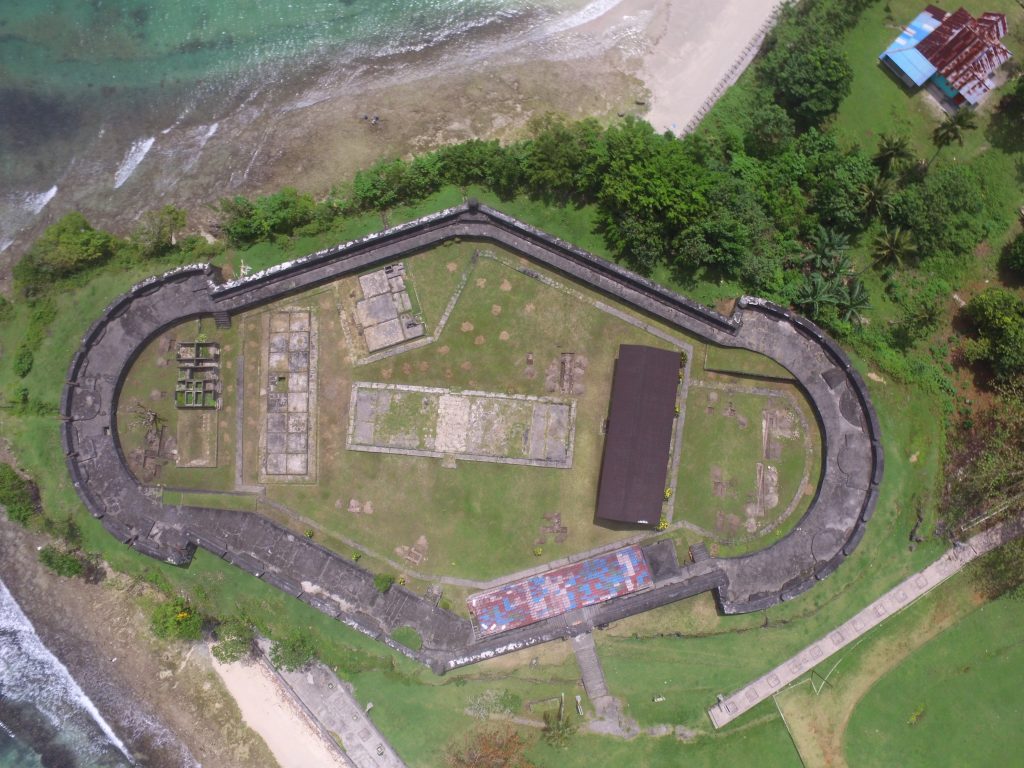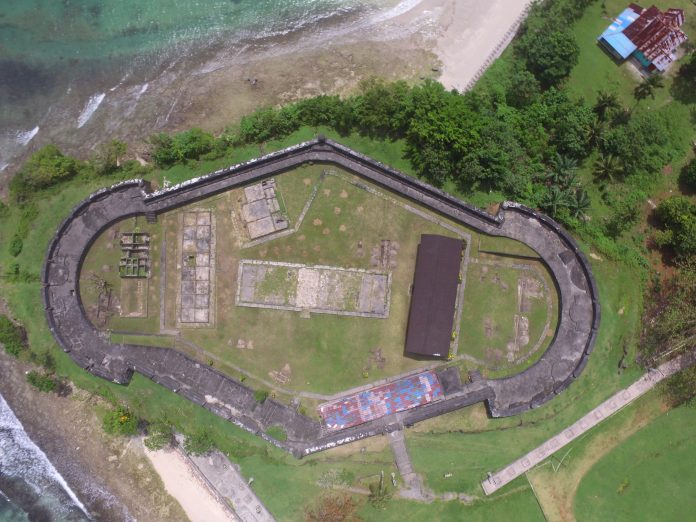
Di pantai selatan Pulau Saparua, yang sangat penting bagi VOC karena perdagangan cengkih, di puncak tebing di atas Sirisori, berdiri Benteng Duurstede yang monumental. Benteng ini menggantikan Benteng Holandia yang berasal dari tahun 1671 yang terletak di tempat yang kurang strategis. Pembangunan Benteng Duurstede dimulai pada tahun 1690 dan selesai pada tahun 1691 di bawah Gubernur Ambon, Nicholas Schagen (1691-1696) yang menganggap benteng ini sebagai salah satu bangunan terbaik yang dibangun di bawah pengawasannya. Pemindahan dari Benteng Holandia ke Benteng Duurstede dilakukan pada tahun 1692. Di benteng yang baru, 10 tentara dan satu kopral tinggal di sana. Ketika sejumlah benteng lain ditinggalkan, pentingnya Benteng Duurstede sebagai pusat administrasi VOC meningkat, akhirnya lebih banyak pasukan ditempatkan di sini.
Namun, peristiwa bersejarah yang paling penting terjadi di sini setelah masa VOC. Pada bulan Mei 1817, benteng ini diserang oleh orang-orang Saparua di bawah komando Thomas Matulessy (Pattimura Muda), seorang Ambon beragama Kristen yang pernah menjabat sebagai sersan walikota di Angkatan Darat Inggris. Semua penghuni benteng dibunuh kecuali anak laki-laki residen, Jan Rudolf van den Berg. Pemberontakan akhirnya dipatahkan dan Benteng Duurstede dikembalikan kepada Belanda, sementara Thomas Matulesst ditawan. Bersama dengan sejumlah rekan-rekannya sesama pemberontak, ia dihukum gantung di Benteng Nieuw Victoria pada pertengahan Desember di tahun yang sama. Setelah kemerdekaan Indonesia, Thomas Matulessy diakui sebagai pahlawan nasional dan diberi nama Pattimura. Benteng Duurstede memiliki tempat khusus dalam sejarah Indonesia.
Benteng Duurstede berdiri di atas bukit di sepanjang pesisir pantai Desa Saparua. Karena lokasinya yang relatif tinggi, benteng ini dapat dilihat dari seluruh teluk dan dusun-dusun di sekitarnya. Benteng ini memiliki struktur berbentuk wajik yang memanjang. Denah yang sangat tidak umum ini dihasilkan dari bentuk tebing. Di sudut utara dan selatan dibangun benteng setengah lingkaran, dilengkapi dengan embrasur. Meriam tua masih ditemukan di beberapa lubang. Pintu masuk ke dalam benteng adalah melalui gerbang kecil di timur laut, dengan 24 anak tangga yang terbuat dari batu. Di atas pintu gerbang terdapat lambang VOC yang dipahat dengan nama orang yang memerintahkan pembangunan benteng dan tahun pembangunannya. Benteng ini terbuat dari batu koral dengan dinding setinggi sekitar 3,4 meter. Tembok sebelah selatan berbatasan langsung dengan laut.
Sebelumnya terdapat beberapa bangunan di dalam benteng, seperti rumah komandan, rumah untuk dokter dan staf, tempat penyimpanan cengkih dan amunisi, kantor, tempat penampungan air, dan tempat pemandian dengan air yang cukup bersih dan dapat diminum. Namun, saat ini, semua bangunan tersebut telah menjadi reruntuhan dan hanya fondasinya saja yang masih dapat dilihat. Ada beberapa reruntuhan bangunan di dalam benteng, yang merupakan sisa-sisa bangunan yang didirikan pada masa awal kemerdekaan Indonesia. Pada tahun 1977-1978, benteng ini dipugar dan sebuah ruang untuk menerima kunjungan ditambahkan di dinding timur laut. Pada tahun 1995, benteng ini dipugar dan sejak saat itu menjadi daya tarik yang populer bagi para wisatawan.
In English:

On the south coast of the island of Saparua, which was very important to the VOC because of the trade in cloves, stands the monumental Fort Duurstede on the top of a cliff above Sirisori. It succeeded fort Fort Holandia dating from 1671, which was located on a less strategic point. The construction of Fort Duurstede started in 1690 and was finished in 1691 under Governor of Ambon, Nicholas Schagen (1691-1696) who considered the fort to be one of the best structures built under his supervision. The move from Fort Holandia to Fort Duurstede took place in 1692. In the new fort 10 soldiers and one corporal took their residence. When a number of other forts were abandoned the importance of Fort Duurstede as a centre of VOC administration increased, and eventually more troops were stationed there.
The most significant historical event, however, took place here after the time of the VOC. In May 1817, the Saparua people attacked the fort under the command of Thomas Matulessy (Pattimura Muda), a Christian Ambonese who had served as sergeant-mayor in the British Army. All the inhabitants of the fort were killed except the young son of the resident, Jan Rudolf van den Berg. The rebellion was eventually broken and Fort Duurstede returned to the Dutch while Thomas Matulessy was taken prisoner. Together with a number of his fellow rebels he was hanged at Fort Victoria mid-December that same year. After Indonesian independence Thomas Matulessy was acknowledged a national hero and he was given the name Pattimura. Fort Duurstede thus has a special place in Indonesian history.
Fort Duurstede stands on a hill along the coast of Saparua village. Because of its relatively high location, it can be observed from the whole bay and surrounding hamlets. It has an elongated diamond-shaped structure. This very uncommon ground plan results from the form of the cliff. Semi-circular bastions are built in the north and south corners, provided with embrasures. Old cannons are still found at some of the embrasures. Entrance into the fort is through a small gate in the north east, with 24 steps made of stone. Above the gate stand the VOC monogram an is chiselled the name of the person who ordered the building of the fort and the year of construction. The fort was made of coral stone with a wall of about 3.4 meters high. The south wall directly borders the sea.
Previously there were several buildings inside the fort, such as the commander’s house, houses for the physician and staff, storage for cloves and ammunition, offices, water reservoirs and bathing facilities with sufficiently clean and potable water. At present, however, all those buildings have become ruins and only the foundations can still be seen. There are some ruinous structures inside the fort, these are remnants of buildings that were erected during the initial period of Indonesia’s independence. In 1977-1978 the fort was restored and a reception hall was added on the north east wall. In 1995 the fort was restored and it has since been a popular attraction for tourists.






